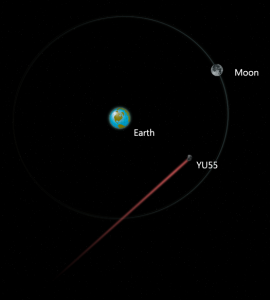
Today on Tuesday, November 8, an asteroid with a diameter of 400 meters will approach Earth’s atmosphere. Named Asteroid 2005 YU55, and deemed “potentially hazardous” by the Minor Planet Center in Cambridge, Ma. will fortunately miss Earth by 0.85 lunar distance, or approximately 335,000 kilometers (208,000 miles).
The approach will mark the closest a known object with this size, has ever gotten to a collision with Earth since 1976. This will as far as we know, continue to hold true until Asteroid 2001 WN5 gets within 0.6 lunar distance in 2028. The Asteroid visiting this evenings was discovered 6 years ago in 2005, and was later named Asteroid 2005 YU55 accordingly. Since this discovery was done rather late, there is still possibility that scientists may find other large floating rocks heading our way before the arrival of Asteroid 2001 WN5 in 2028.
Asteroid 2005 YU55 will make its closest approach to Earth at 6:28 p.m. EST (23:28 GMT) this evening. At that point, the space rock will be traveling at about 46,671km/h (29,000 mph) and be about 324,600 kilometers (201,700 miles) from Earth. This is closer than the moon, which orbits approximately at a distance of 384,499 km (238,864 miles) from earth.
Not thought to be a threat to Earth for at least the next few centuries, Asteroid 2005 YU55 may still be a threat for future generations. “2005 YU55 cannot hit Earth at least over the interval that we can compute the motion reliably, which extends for several hundred years,” said Lance Benner, NASA Jet Propulsion Laboratory research scientist, in a recent NASA video.
“It made close approach to Earth about 18 months ago,” added Benner. “In April of 2010, colleagues of ours at Arecibo Observatory were able to observe this asteroid using their radar facility at Arecibo and they were able to obtain radar images that showed that this object is about 400 meters across.”
During the close approach, the asteroid should reach visual brightness of the 11th magnitude, and may be visible to expert observers using high-end binoculars with an objective lens of 80mm or larger. The object will approach Earth this time from the direction of the sun and departs our vicinity toward the bright moon, so you will not be able to anything with the naked eye or even a small telescope. Amateur observers trying to visually locate the asteroid will require a telescope with an aperture of 6 inches (15 centimeters) or larger.
